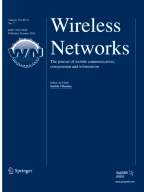Abstract
Positioning of things, devices and people is the fundamental technology in ubiquitous computing. However, few literature has discussed the impact of positioning errors due to localization algorithm properties such as ranging noise and deployment of anchors on people’s identification of objects. Since several factors such as relative distance, relative angles and grouping of objects are intricately related with each other in such identification, it is not an easy task to investigate its characteristics. In this paper, we propose criteria to assess the “accuracy” of the estimated positions in identifying the objects. The criteria are helpful to design, develop and evaluate localization algorithms that are used to tell people the location of objects. Augmented reality is a typical example that needs such localization algorithms. To model the criteria without ambiguity, we prove that the Delaunay triangulation well-captures natural human behavior of finding similarity between estimated and true positions. We have examined different localization algorithms to observe how the proposed model quantifies the properties of those algorithms. Subjective testing has also been conducted using questionnaires to justify our quantification sufficiently renders human intuition.
Similar content being viewed by others
Notes
Without this assumption, identification becomes very hard since rotation should be considered.
References
Olguin, D. O., Waber, B. N., Kim, T., Mohan, A., Ara, K., & Pentland, A. (2009). Sensible organizations: Technology and methodology for automatically measuring organizational behavior. IEEE Transactions on Systems, Man, and Cybernetics, Part B: Cybernetics, 39(1), 43–55.
Lukowicz, P., Timm-Giel, A., Lawo, M., & Herzog, O. (2007). WearIT@work: Toward real-world industrial wearable computing. IEEE Pervasive Computing, 6(4), 8–13.
Yang, Z., & Liu, Y. (2010). Quality of trilateration: Confidence-based iterative localization. IEEE Transactions on Parallel and Distributed Systems, 21(5), 631–640.
Ash, J. N., & Moses, R. L. (2008). On the relative and absolute positioning errors in self-localization systems. IEEE Transactions on Signal Processing, 56(11), 5668–5679.
Matsakis, P., & Wendling, L. (1999). A new way to represent the relative position between areal objects. IEEE Transactions on Pattern Analysis and Machine Intelligence, 21(7), 634–643.
Priyantha, N. B., Chakraborty, A., & Balakrishnan, H. (2000). The cricket location-support system. In Proceedings of the MobiCom (pp. 32–43).
Place engine. http://www.placeengine.com/en.
Shang, Y., Ruml, W., Zhang, Y., & Fromherz, M. P. J. (2003). Localization from mere connectivity. In Proceedings of the ACM MobiHoc (pp. 201–212).
Nagpal, R., Shrobe, H., & Bachrach, J. (2003). Organizing a global coordinate system from local information on an ad hoc sensor network. In Proceedings of the information processing in sensor networks (pp. 333–348).
Fujii, S., Nomura, T., Umedu, T., Yamaguchi, H., & Higashino, T. (2009). Real-time trajectory estimation in mobile ad hoc networks. In Proceedings of the ACM international conference on modeling, analysis and simulation of wireless and mobile systems (pp. 163–172).
Turk, M., & Pentland, A. (1991). Face recognition using eigenfaces. In Proceedings of the IEEE conference on computer vision and pattern recognition (pp. 586–591).
Demirci, M. F., Platel, B., Shokoufandeh, A., Florack, L. L. M. J., & Dickinson, S. J. (2009). The representation and matching of images using top points. Journal of Mathematical Imaging and Vision, 35(2), 103–116.
Bebis, G., Deaconu, T., & Georgiopoulos, M. (1999). Fingerprint identification using Delaunay triangulation. In Proceedings of the IEEE international conference on intelligence, information and sstems (pp. 452–459.
Papari, G., & Petkov, N. (2005). Algorithm that mimics human perceptual grouping of dot patterns. In Proceedings of the international symposium on brain, vision and artificial intelligence (Vol. 3704, pp. 497–506).
Wertheimer, M. (1938). Laws of organization in perceptual forms. A Sourcebook of Gestalt Psycychology, 71–88.
Lee, D.T., & Schachter, B.J. (1980). Two algorithms for constructing a Delaunay triangulation. International Journal of Parallel Programming, 9(3), 219–242.
Bunke, H. (1997). On a relation between graph edit distance and maximum common subgraph. Pattern Recognition Letters, 18(8), 689–694.
Murtagh, F. (1983). A survey of recent advances in hierarchical clustering algorithms. The Computer Journal, 26(4), 354–359.
Macqueen, J. B. (1967). Some methods of classification and analysis of multivariate observations. In Proceedings of the Berkeley symposium on mathematical statistics and probability (pp. 281–297.
Ward, J.H. (1963). Hierarchical grouping to optimize an objective function. Journal of the American Statistical Association, 58(301), 236-244.
Sokal, R.R., & Michener, C.D. (1958). A statistical method for evaluating systematic relationships. University of Kansas Scientific Bulletin, 28, 1409–1438.
E-triage project. http://www-higashi.ist.osaka-u.ac.jp/research/e-triage.html.
Shang, Y., Ruml, W., Zhang, Y., & Fromherz, M. (2004). Localization from connectivity in sensor networks. IEEE Transactions on Parallel and Distributed Systems, 15(11), 961–974.
Carroll, J. D., & Chang, J. J. (1970). Analysis of individual differences in multidimensional scaling via an N-way generalization of Eckart-Young decomposition. Psychometrika, 35(3), 283–319.
Acknowledgments
This research was supported by JST, CREST.
Author information
Authors and Affiliations
Corresponding author
Rights and permissions
About this article
Cite this article
Kiyama, N., Uchiyama, A., Yamaguchi, H. et al. Quantifying relationship between relative position error of localization algorithms and object identification. Wireless Netw 19, 1037–1049 (2013). https://doi.org/10.1007/s11276-012-0516-2
Published:
Issue Date:
DOI: https://doi.org/10.1007/s11276-012-0516-2
